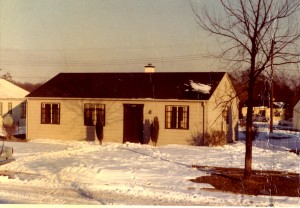Lessons in Pottery
Back in 1958 BC (Before Children) we rented a little house in a subdivision called Harundale in Glen Burnie, MD. Our yard was non-descript except that we didn’t have much soil and what there was had been put on top of a layer of red clay. During rains the red clay would ooze to the top and any soil that wasn’t anchored down by grass just washed away.
Grass wasn’t so important to us back then. All we could see was the potential of the red clay––
We could become potters and the clay would all be free!
We got books on the subject so we could do this correctly. We dug up a couple pails full of the clay and then proceeded to sift it, as recommended. Our sieve was homemade using window screen attached to a square wood rectangle. We squatted over the sieve, rubbing our hands back and forth to get rid of the stones, roots, bits of grass, leaves––all the things that could lead to great imperfections in our final projects. Our hands were bright red. We were covered in red dust from top to bottom, but beautiful fine clay dust came out the bottom of the sieve.
We set up a table in a little extra bedroom, mixed the clay with the right amount of water, and began our pottery making. We made little free-shaped dishes and bowls, little abstract sculptures, little pots––all misshapen, uneven and bumpy, though beautiful to our eyes.
But now we had to fire them in a kiln. A kiln? We couldn’t afford a kiln. That didn’t deter us. Mark went up to Baltimore and bought some white fire bricks. He held the bricks together as a hollow box with heavy wire and turnbuckles. He built a cover. He made our heating elements out of toaster wires, 3 sets, each in a groove inside. There were switches outside to select them for various heats. With all 3 wires running, the inside rapidly reached a cherry red. Then we drilled a couple holes into the sides of the bricks so we could see the cone and would be able to tell when our greenware was ready.
With great love we placed our various creations into the kiln, and they baked at the proper temperatures until the cones melted. We let them cool, then took them out. They still were misshapen, bumpy, and lumpy, but to our eyes they were still beautiful.
Of course the next step was to glaze them. We went to a pottery supply store and found a few glazes on sale. We had great fun applying the colors, predicting how our creations would look in the end, secretly hoping they would cover the imperfections. They didn’t––no more than painting a wall over nail holes with hopes they’d disappear. But the glazed colors looked great. We were proud of our achievements.
Of course now that we had mastered this level of pottery we felt ready for a potter’s wheel. Seemed to us that it should be fairly easy to use one. Unfortunately, our minimal budget wouldn’t allow for such an expenditure, so once again Mark put his engineering talents to use; or at least his junk box to use —
He dug out an old 78rpm record player and this became our potter’s wheel.
We read our books and looked at photos to see how to place the clay and how to hold our hands to form the pots.
We had the system. Ready, get set, go! I poised my hands around the clay, and Mark plugged in the record player. Zip! It spun around so fast I couldn’t do anything. The clay flew off the turntable at high speed and hit every wall in the room along with us. Needless to say, we never tried a potter’s wheel again.
But something beautiful did come from our immersion in clay. Mark had studied Russian at Brown University and wanted to make a Russian Scrabble game. Back then, at least as far as we knew, there was no such game. He rolled out a nice even, flat sheet of clay, and he cut out tiles about ¾” square. He figured out the frequency of use for each Russian character and then with painstaking precision he etched them into the tiles. After they were baked he painted them with white glaze and filled each etched symbol with bright red. They came out beautifully. He next made a Scrabble board––the English board contained too few squares.
We couldn’t play the game. I didn’t know any Russian.
The joy, as always, was in the doing.
We’d often show it to friends. We even lent it to someone who was studying Russian. Today, I fear, we don’t know where it is. Hopefully in a box we have packed away, maybe close to the box that has all the lumpy bumpy creations we made earlier. It would have been nice to have set it up and taken a photo of it for this blog.
We never did any more projects in clay––but our children did and they used the kiln quite successfully. Today I marvel over the pottery others have made with total envy of their skills, although I bet most haven’t experienced the joy of using clay dug up from their yards!
Did you enjoy this post? Why not leave a comment below and continue the conversation, or subscribe to my feed and get articles like this delivered automatically to your feed reader.





Thank you, Deborah. It was such fun to read your comment and so glad you “stumbled” to our blog. Certainly hope you do again. Denise